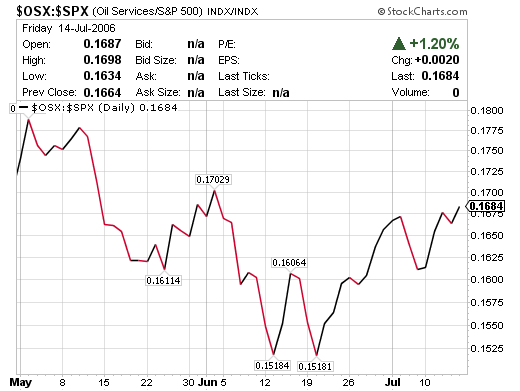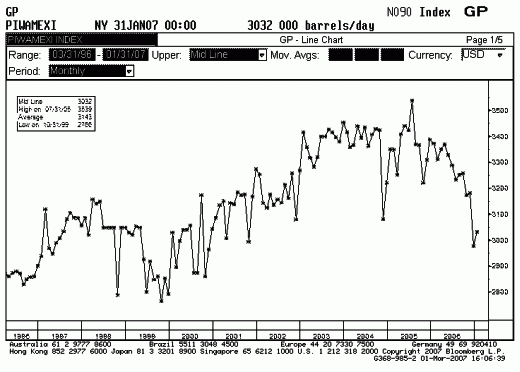Energy Markets Survive Global Financial Markets Sell off
Commodities / Crude Oil Mar 05, 2007 - 05:40 PM GMTBy: Elliot_H_Gue

The sudden, sharp drop in global equity markets Tuesday has been the subject of almost endless chatter in the financial media this week. But for the most part, this global selloff failed to touch the energy markets.
As of Thursday's close, crude oil and gasoline prices were actually higher for the week. And energy stocks, as measured by the Philadelphia Oil Services Index, were down only around 1.5 percent, a modest move for that index. Energy-related stocks and commodities were among the few green up-arrows in a sea of red on trading screens Tuesday.
Although four days is far too short a period to use as a basis for making grandiose projections, the contrast with the May/June selloff last year is instructive. Check out the chart below for a closer look.

Source: StockCharts.com
This chart shows a simple ratio--the value of the Philadelphia Oil Services Index divided by the S&P 500. The interpretation is simple: When the line is rising, oil services stocks are outperforming the S&P 500. And, of course, when the line is falling, that means services stocks are falling faster than the market as a whole.
As you can clearly see, the oils actually led the market lower during last year's global hiccup. This week, the exact opposite has been the case. That suggests there's some underlying strength in the energy patch.
I see a few reasons for the energy markets—both commodities and related stocks--to outperform. First, last May most energy commodities and stocks had been locked in an impressive rally for months based on solid earnings news and generally positive fundamentals. Hedge funds, mutual funds and retail investors alike were loaded to the gills with energy-related investments. Therefore, the sector couldn't handle any disappointing news and was subject to violent bouts of profit-taking at the first sign of trouble.
But that's not the case today. Most oil- and gas-related stocks have been trading sideways for months. And, as I pointed out in the January 12 issue of The Energy Letter , futures traders are far less bullish on oil than they were last spring.
More important, however, fundamentals for the energy markets continue to improve. Specifically, on the oil front, one of the most important developments this year has been the disappointing production from countries outside the Organization of the Petroleum Exporting Countries (OPEC) oil cartel.
One of the biggest arguments last year from the oil bears was that non-OPEC oil production was scheduled to grow faster in 2007 that it has since the 1980s. Back in October, the International Energy Agency (IEA) estimated that non-OPEC oil supplies would grow by 1.8 million barrels per day this year over 2006 levels.
This is oil bearish for two reasons. First, economics 101 tells us that when supply grows relative to demand, prices fall. Second and more important, non-OPEC supplies are typically considered more desirable than OPEC supplies because non-OPEC supplies have traditionally carried less political risk.
What's more, being outside the cartel, non-OPEC production isn't affected by OPEC decisions to cut oil quotas and attempt to support oil prices.
But that estimate hasn't quite panned out. During the past four months, a host of non-OPEC oil producers have emerged to revise lower their estimates for the year. Earlier this year, in fact, the IEA had to revise lower its non-OPEC production growth estimate to just 1.45 million barrels per day.
You'll probably see more serious downside revisions to come during the next few months. I remain particularly concerned about production from Mexico. Check out the chart below.

Source: Energy Intelligence Group , Bloomberg
This chart shows Mexico's monthly oil production over the past 11 years. As you can see, production held up nicely around 3.5 million barrels per day in the period from 2003-05. But, last year, Mexican production fell off the proverbial cliff, slipping under 3 million barrels per day late in the year before rebounding slightly in January.
The main culprit for Mexico's decline: the country's giant Cantarell Oil Field, one of the largest and most-prolific oilfields in the world. Cantarell once accounted for more than 2 million barrels per day of Mexico's production.
The problem with Cantarell is that production has peaked and now it's a maturing field. To maintain production from maturing fields requires massive investment, and Mexico just isn't funding that investment as it should.
Mexico's national oil company, Pemex , estimates that Cantarell production will fall off nearly 400,000 per day between 2006 and 2008. But its estimates have proved overly optimistic lately; the falloff in production is likely to be steeper than that.
Estimates are that it would take $10 billion to $12 billion in annual investment on this field to stem the production declines; Mexico currently only spends around $1.5 to $2 billion annually on Cantarell.
Editor's Note: I'd like to extend a special invitation for all readers to join me along with my fellow editors Neil George and Roger Conrad for the 17th Annual Atlanta Investment Conference, April 19-21, at Chota Falls outside Atlanta.
Although I attend several shows and conferences every year, this one has always been truly special. The show is limited to only 175 people, so it's a smaller, more intimate group, affording far more opportunity for interaction between speakers and attendees. And it's hard to imagine a more spectacular setting--right in the heart of the Georgia mountains.
And, most important, all proceeds from the show go to an outstanding charity, the Friends for Autism Foundation. If you'd like to join me at the show, go to www.aicatchota.com or call 678-778-8136 to register. Don't forget to tell them I sent you. I look forward to seeing you there.
By Elliott H. Gue
The Energy Letter
© 2007 Elliott H. Gue
Elliott H. Gue is editor of The Energy Letter , a bi-weekly e-letter as well as editor of The Energy Strategist , a premium bi-weekly newsletter on the energy markets. Mr. Gue is also associate editor for Personal Finance , where he contributes his knowledge of the energy markets.
Mr. Gue has a Master's of Finance degree from the University of London and a Bachelor of Science degree in Economics and Management from the University of London , graduating in the top 3 percent of his class. Mr. Gue was the first American student to ever complete a full degree at that university.
© 2005-2022 http://www.MarketOracle.co.uk - The Market Oracle is a FREE Daily Financial Markets Analysis & Forecasting online publication.


